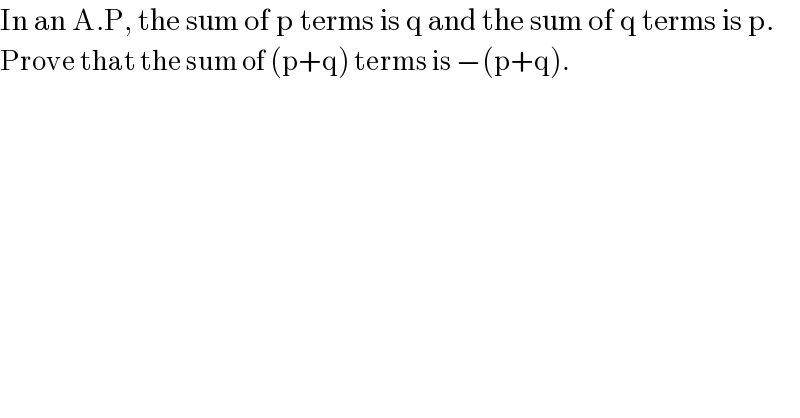
Question Number 21502 by 786786AM last updated on 25/Sep/17

$$\mathrm{In}\:\mathrm{an}\:\mathrm{A}.\mathrm{P},\:\mathrm{the}\:\mathrm{sum}\:\mathrm{of}\:\mathrm{p}\:\mathrm{terms}\:\mathrm{is}\:\mathrm{q}\:\mathrm{and}\:\mathrm{the}\:\mathrm{sum}\:\mathrm{of}\:\mathrm{q}\:\mathrm{terms}\:\mathrm{is}\:\mathrm{p}. \\ $$$$\mathrm{Prove}\:\mathrm{that}\:\mathrm{the}\:\mathrm{sum}\:\mathrm{of}\:\left(\mathrm{p}+\mathrm{q}\right)\:\mathrm{terms}\:\mathrm{is}\:−\left(\mathrm{p}+\mathrm{q}\right). \\ $$
Answered by $@ty@m last updated on 25/Sep/17
![ATQ S_p =q (p/2)[2a+(p−1)d]=q ⇒2a+(p−1)d=((2q)/p) −−(1) S_q =p (q/2)[2a+(q−1)d]=p ⇒2a+(q−1)d=((2p)/q) −−(2) Subtracting (2) from (1) (p−1−q+1)d=((2q)/p)−((2p)/q) (p−q)d=((2(q^2 −p^2 ))/(pq)) d=((−2(p+q))/(pq)) −−(3) ∴ from (1), 2a+(p−1)((−2(p+q))/(pq))=((2q)/p) 2a=((2(p−1)(p+q))/(pq))+((2q)/p) −−−(4) ∴ S_(p+q) =((p+q)/2)[2a+(p+q−1)d] ⇒S_(p+q) =((p+q)/2)[((2(p−1)(p+q))/(pq))+((2q)/p)+(p+q−1)((−2(p+q))/(pq))] from (3) &(4) =((2(p+q))/(2pq))[p^2 −p+pq−q+q^2 −(p+q)^2 +p+q] =((p+q)/(pq))×(−pq) =−(p+q) Q.E.D.](Q21505.png)
$${ATQ} \\ $$$$\boldsymbol{\mathrm{S}}_{{p}} ={q} \\ $$$$\frac{{p}}{\mathrm{2}}\left[\mathrm{2}{a}+\left({p}−\mathrm{1}\right){d}\right]={q} \\ $$$$\Rightarrow\mathrm{2}{a}+\left({p}−\mathrm{1}\right){d}=\frac{\mathrm{2}{q}}{{p}}\:−−\left(\mathrm{1}\right) \\ $$$$\boldsymbol{\mathrm{S}}_{{q}} ={p} \\ $$$$\frac{{q}}{\mathrm{2}}\left[\mathrm{2}{a}+\left({q}−\mathrm{1}\right){d}\right]={p} \\ $$$$\Rightarrow\mathrm{2}{a}+\left({q}−\mathrm{1}\right){d}=\frac{\mathrm{2}{p}}{{q}}\:−−\left(\mathrm{2}\right) \\ $$$${Subtracting}\:\left(\mathrm{2}\right)\:{from}\:\left(\mathrm{1}\right) \\ $$$$\left({p}−\mathrm{1}−{q}+\mathrm{1}\right){d}=\frac{\mathrm{2}{q}}{{p}}−\frac{\mathrm{2}{p}}{{q}} \\ $$$$\left({p}−{q}\right){d}=\frac{\mathrm{2}\left({q}^{\mathrm{2}} −{p}^{\mathrm{2}} \right)}{{pq}} \\ $$$${d}=\frac{−\mathrm{2}\left({p}+{q}\right)}{{pq}}\:\:\:−−\left(\mathrm{3}\right) \\ $$$$\therefore\:{from}\:\left(\mathrm{1}\right), \\ $$$$\mathrm{2}{a}+\left({p}−\mathrm{1}\right)\frac{−\mathrm{2}\left({p}+{q}\right)}{{pq}}=\frac{\mathrm{2}{q}}{{p}} \\ $$$$\mathrm{2}{a}=\frac{\mathrm{2}\left({p}−\mathrm{1}\right)\left({p}+{q}\right)}{{pq}}+\frac{\mathrm{2}{q}}{{p}}\:\:−−−\left(\mathrm{4}\right) \\ $$$$\therefore\:\boldsymbol{\mathrm{S}}_{{p}+{q}} =\frac{{p}+{q}}{\mathrm{2}}\left[\mathrm{2}{a}+\left({p}+{q}−\mathrm{1}\right){d}\right] \\ $$$$\Rightarrow\boldsymbol{\mathrm{S}}_{{p}+{q}} =\frac{{p}+{q}}{\mathrm{2}}\left[\frac{\mathrm{2}\left({p}−\mathrm{1}\right)\left({p}+{q}\right)}{{pq}}+\frac{\mathrm{2}{q}}{{p}}+\left({p}+{q}−\mathrm{1}\right)\frac{−\mathrm{2}\left({p}+{q}\right)}{{pq}}\right] \\ $$$$\:\:\:\:\:\:\:\:\:\:\:\:\:\:\:\:\:\:\:\:\:\:\:\:\:\:\:\:\:\:\:\:{from}\:\left(\mathrm{3}\right)\:\&\left(\mathrm{4}\right) \\ $$$$\:\:\:\:\:\:\:\:\:\:\:\:\:\:\:=\frac{\mathrm{2}\left({p}+{q}\right)}{\mathrm{2}{pq}}\left[{p}^{\mathrm{2}} −{p}+{pq}−{q}+{q}^{\mathrm{2}} −\left({p}+{q}\right)^{\mathrm{2}} +{p}+{q}\right] \\ $$$$\:\:\:\:\:\:\:\:\:\:\:\:\:\:\:=\frac{{p}+{q}}{{pq}}×\left(−{pq}\right) \\ $$$$\:\:\:\:\:\:\:\:\:\:\:\:\:\:\:=−\left({p}+{q}\right) \\ $$$$\:\:\:\:\:\:\:\:\:\:\:\:\:\:\:\:\mathrm{Q}.\mathrm{E}.\mathrm{D}. \\ $$
